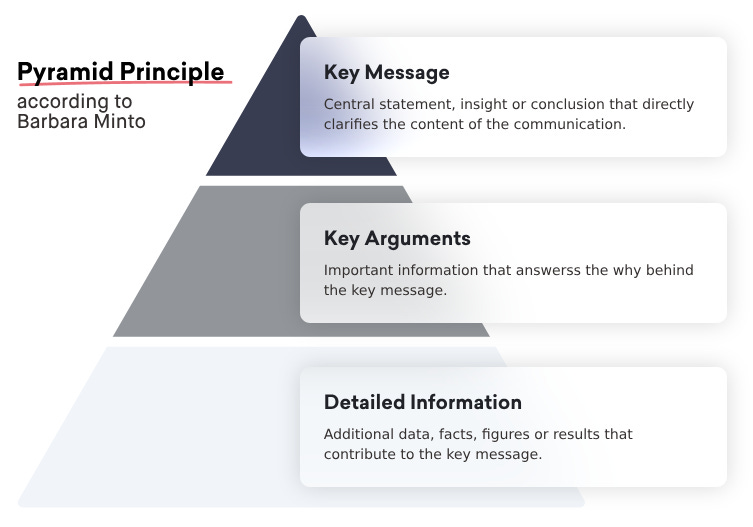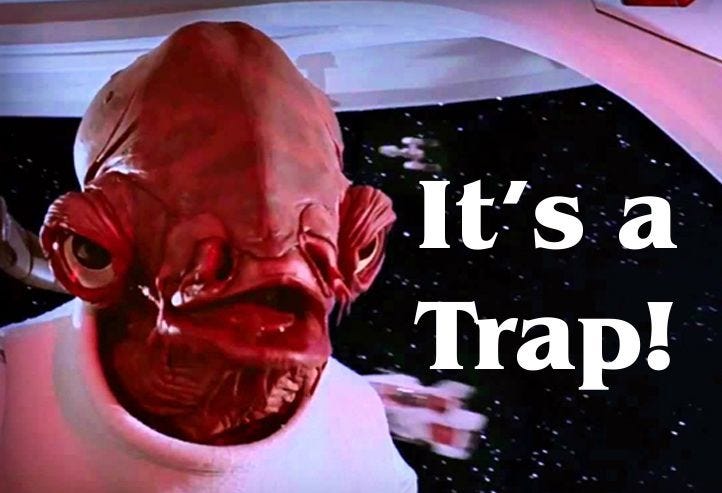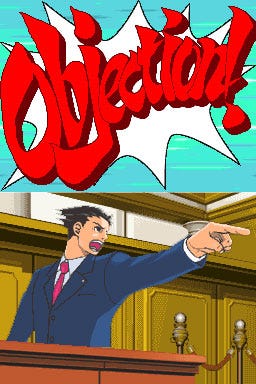Welcome! I’m Vincent and this is a Product Manager’s Notebook, a series of notes for people who are interested in sharing and learning the art of product management and career development. You can read my archive here.
If you appreciate reading this post, please consider liking and subscribing
As product managers, making and giving presentations is part of our bread and butter. Whether they're internal or external, PowerPoint or Google Slides (hey what happened to Prezi, that was cool for a while), there are universal truths that can be applied.
One of them is: there are a lot of bad presentations.
I would know - a lot of them were mine.
The reason why? We were all taught to make presentations at school, presenting school projects and assignments. As we move onto our professional lives, we continue to make presentations and most of us think we're “pretty darn good” at it.
A presentation often looks like this:
Agenda
Research
Data
Outcome
Very chronological.
The problem is that accuracy and completeness do not make an effective presentation. ❌
Instead, presenting powerful stories with compelling evidence have a far stronger impact to get you to where you want to go. ✅
Here are some of tips I’ve learned over time, that have become a mental checklist when I make my presentations these days. Note my emphasis is on the structure and content, rather than your presentation style. My hope is that you’ll be able to absorb and adopt this into your own style.
It looks like this:
Have a clear message or outcome in mind
Know your target audience
Bring your key points up front
Keep things clear and concise
Avoid distractions
Without further ado, let’s speedrun through these - faster than Tom Cruise running from scenic location A to scenic location B.

1. Have a clear outcome in mind
What’s the point in your presentation? Is it to present a point of view for a feature enhancement, make a commercial proposal or to invite participation into an exchange of thoughts?
Is it a call to action and if so, what is that?
Feedback I’ve received: “Was it a business update or were you asking them to do something? It was unclear which this was meant to be and I don’t think you achieved what you set out to.”
Often times, we want to mention many things at the same time, and generally it’s because it’s not clear what we are trying to say. In response and to fill in the space, we say everything. Unfortunately, this tends to muddy the water and confuse your audience.

Instead, focus on the intended outcome of your presentation and tailor everything towards that one message.
Are you asking senior management to approve your idea?
Are you asking Sales to start pitching your product?
Are you asking Customer support to change the way they handle your customer’s tickets?
Without a clear intention, there can be no clear outcome.
2. Know your target audience
It’s so important to understand your audience. How do they like to receive information and what do they care about? What is their relationship to your product - and to you?

If it’s Sales, they may want to hear about potential revenue and market opportunity. Your technical detail on the back end architecture will be completely lost on them.
If it’s an Engineering leader, which part of your product are they responsible for and what do they care about most? Is it saving resources by using third party elements or creating and using your own in-house building blocks? How do they like to measure impact or success?
If you are presenting options to your senior management team, what pieces of information do they have to know? Is it business impact or edge versus competitors? Is it deepening our engagement with existing customers or penetrating a new market segment?
Having a sound understanding helps you to ensure you’re speaking the same language as your audience and communicating on the same level.
3. Bring your key points up front
The risk of steadily building up to your conclusion is this: most of the time you simply won’t get to it. Whether it’s time constraints or loss of attention, that *most important* part of your presentation can often easily get lost.
There is a useful framework here that can help, and it’s called the Minto Pyramid.

Coined by Barbara Minto, a pioneering consultant at McKinsey, the idea is that your ideas should structured as follows:
Key Message - what is the conclusion meant to be
Key Arguments - why you’ve come to this conclusion
Detailed information - the how and other details
Get to the point right from the start so your audience understands the intended goal of this presentation. Then explain why in the following slides - after all, we are product managers who have a view that is based on a solid understanding of the why.
Why is this important? Why we suggest this way compared to other alternatives. Why do we think this is the best thing to do for the business and our customers?
Your Appendix is your friend here, for any information that could come in useful but shouldn’t be part of the main content. Slides, tables, anecdotes. If they’re not part of your main story, put them in the Appendix.
4. Keep things clear and concise
You’re writing your slide deck. You write one thing and then another. As you try and cover more and more, the deck grows. You scroll down the side to see how many slides you have: 34.
Death by Powerpoint is a real problem.
I’ve seen far too many presentations where entire slides were covered in words - font 12 no less. Your audience has a choice of either listening to you or reading. The general rule is that they can’t do both.
Keep it clean and simple.
Highlight what you want your audience to care about, whether it’s different colours or bolding. Use bulletpoints (as currently demonstrated).
If you can, try to stick to the rule of 3, since the human mind has a penchant to find that a familiar rhythm and easier to remember new concepts or ideas.
These aren't hard and fast rules, and as with everything in Product, it depends. If your management prefers detailed presentations with information they can read through before the meeting, then you adapt.
If it’s a technical presentation with system designs, you need to have visuals and flows for a discussion to take place. On this note, diagrams and visuals are always useful instead of text - as long as they’re relevant.
5. Avoid distractions
Perhaps one of the most important lessons I’ve learned about making effective presentations, is that it is often about avoiding distractions or pitfalls.
What do I mean by these?
Often times in a presentation, something will appear on the screen that triggers the audience. Almost involuntarily, they feel compelled to ask a question or question the narrative that’s being presented. It could look like this:
1. Questionable data analysis
You’ve directly presented your data as per your analysis without further cleaning. What's the difference between “N/A” and “Unknown”? What is that tiny slice of the pie chart you can barely see? Does it matter to the audience? This can happen when you’re being overly specific or too vague. The audience needs to ask “what does that actually mean?”
2. Strong (potentially controversial) statements
This could be a suggestion of an impact number, or an implication of a direct cause and effect between two factors. “Fixing this feature will result in x revenue”.
Will it? Why?
Are we saying that just fixing this is going to bring in money, or is there (more likely) in reality a bunch of other factors in play? Before long, you’re spending your whole time defending or explaining the statement you’ve made.
If your presentation contains statements that will not reflect well 3 questions deep, you’re better off not making them.
3. Triggering language
A little similar to the above, knowing your audience means having a sense of things that will trigger/bother/infuriate them. Whether it’s statements about cannabilization when they want to keep products clean, or mention of tactical initiatives when they only want to hear strategic goals - mentioning these will potentially also completely derail your presentation.
Let’s recap:
Know your target audience
Have a clear outcome in mind
Bring your key points up front
Keep it clean and concise
Avoid distractions
Bear these in mind and you’ll be making more effective presentations in no time.
Good luck! 👍🏻








